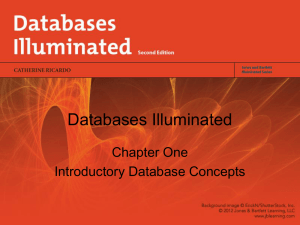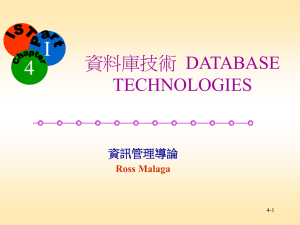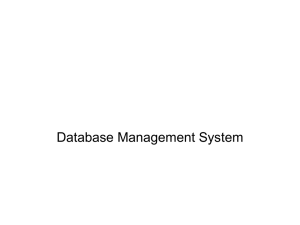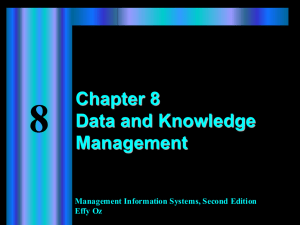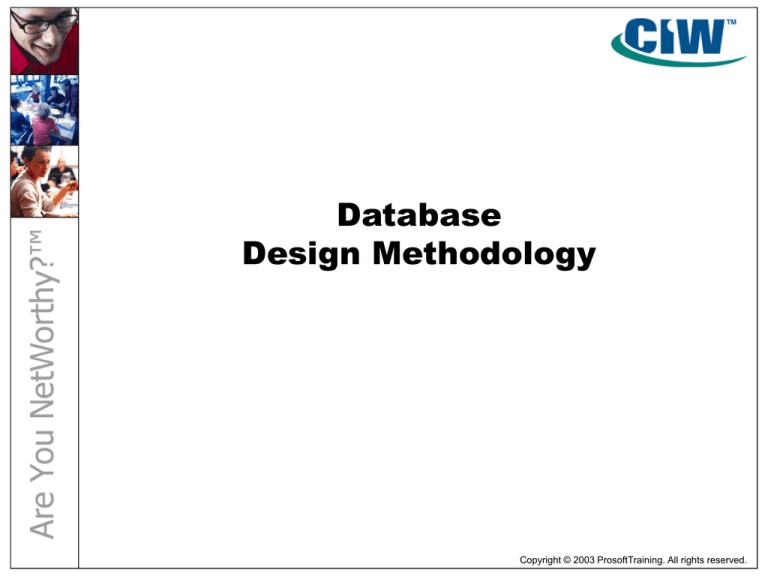
Database
Design Methodology
Copyright © 2003 ProsoftTraining. All rights reserved.
Lesson 1:
Introduction to Databases
Copyright © 2003 ProsoftTraining. All rights reserved.
Objectives
•
•
•
•
Define a database
Identify and discuss file-based data systems
Define relational database
Define and describe DBMSs, and identify their
advantages and disadvantages
• Choose the correct type of database
• Discuss the origins of relational databases
What Is
a Database?
• File-based databases
– Flat-file databases
• The evolution of databases
Relational Databases
and DBMSs
•
•
•
•
•
Relational databases
Structured Query Language
Database administrator
Advantages and disadvantages of DBMSs
Choosing the correct database type
The Origins of
Relational Databases
• Codd first proposed the relational data model
in 1970
• System R
• Development of SQL
• INGRES
• IBM UK Scientific Center
Summary
Define a database
Identify and discuss file-based data systems
Define relational database
Define and describe DBMSs, and identify their
advantages and disadvantages
Choose the correct type of database
Discuss the origins of relational databases
Lesson 2:
Relational
Database Fundamentals
Copyright © 2003 ProsoftTraining. All rights reserved.
Objectives
• Define and discuss multitier database
architecture
• Define relational model terminology
• Describe different relational table types
• Explain primary and foreign keys
• Discuss data models and data relationships
• Define database languages
Multitier
Database Architecture
• Two-tier client-server architecture
– Fat client
• Three-tier client-server architecture
– Thin client
• n-tier architecture
Relational
Model Terminology
• Relational data
structure
• Rows (tuples)
• Columns (attributes)
•
•
•
•
Domains
Degrees
Cardinality
Normalization
Using Tables
to Represent Data
•
•
•
•
•
Entities
Characteristics of relations
Types of tables
Primary keys
Foreign keys
Data
Models
• Components
– Structural information
– Manipulative information
– Integrity information
Entities and
Data Relationships
• Entity-Relationship modeling
• Strong entities
• Weak entities
Relational Integrity
•
•
•
•
Domain constraints
Entity integrity
Referential integrity
Views
Database Languages
•
•
•
•
Data definition language
Data manipulation language
Data control language
Data dictionaries
Summary
Define and discuss multitier database
architecture
Define relational model terminology
Describe different relational table types
Explain primary and foreign keys
Discuss data models and data relationships
Define database languages
Lesson 3:
Database Planning
Copyright © 2003 ProsoftTraining. All rights reserved.
Objectives
•
•
•
•
•
Explain the database design life cycle
Discuss database planning
Describe a database requirements document
Discuss the criteria for selecting a DBMS
Discuss the criteria for selecting an
application interface
Database
Design Life Cycle
• Create a database
strategy
• Define database
application scope
• Create a database
requirements
document
• Design the database
• Select a DBMS
• Design the database
application
• Create database
prototypes
• Test the database
application
• Implement the
database
application
• Convert legacy
data
• Maintain the
database
Database
Requirements Document
• Conducting interviews
• Requirements document information
Selecting a DBMS
• Selection criteria
– Data definition functionality
– Physical criteria
– Access criteria
– Transactions
– Utilities
– Development tools
– Miscellaneous features
Selecting an
Application Interface
• GUI considerations
– Descriptive page titles
– Clear instructions
– Consistent grouping of input fields
– Logically labeled fields
– Consistent color use
– Properly sized data entry fields
– Logical cursor movement
– Error messages
– Clearly indicated optional fields
– Completion message
Summary
Explain the database design life cycle
Discuss database planning
Describe a database requirements document
Discuss the criteria for selecting a DBMS
Discuss the criteria for selecting an
application interface
Lesson 4:
Overview of Database
Design Methodology
Copyright © 2003 ProsoftTraining. All rights reserved.
Objectives
• Describe relational database design
methodology
• Identify the effects of poor design practices
• Create Entity-Relationship models
• Identify entities and relationship types
• Identify entity attributes and domains
• Determine primary and candidate keys
Effects of
Poor Database Design
• Insertion anomalies
• Deletion anomalies
• Update anomalies
Database
Design Phases
• Conceptual phase
• Logical phase
• Physical phase
Conceptual
Database Design
• Identifying entities
• Identifying attributes and attribute domains for
entities
• Identifying relationships
• Identifying candidate and primary keys for
entities
• Creating an Entity-Relationship diagram
• Reviewing the ER model by the user and
design team
Entity-Relationship Models
•
•
•
•
Creating ER models
Defining domains
Common SQL data types
Determining data relationships
– Recursive relationships
Summary
Describe relational database design
methodology
Identify the effects of poor design practices
Create Entity-Relationship models
Identify entities and relationship types
Identify entity attributes and domains
Determine primary and candidate keys
Lesson 5:
Normalization
Copyright © 2003 ProsoftTraining. All rights reserved.
Objectives
•
•
•
•
•
•
•
Define normalization
Explain normal forms
Define and discuss 1NF
Define and discuss 2NF
Define and discuss 3NF
Define and discuss BCNF
Explain the normalization process
What Is
Normalization?
• Normal forms
• First normal form
– First normal form anomalies
• Second normal form
– Second normal form anomalies
• Third normal form
• Boyce-Codd normal form
Related Concepts
•
•
•
•
•
Decomposition
Atomic value
Partial functional dependency
Transitive dependency
Denormalization
Summary
Define normalization
Explain normal forms
Define and discuss 1NF
Define and discuss 2NF
Define and discuss 3NF
Define and discuss BCNF
Explain the normalization process
Lesson 6:
Logical Database Design
Copyright © 2003 ProsoftTraining. All rights reserved.
Objectives
• Identify logical database design issues
• Identify the cardinality of data relationships
• Create a logical data model from a conceptual
data model
• Use a database definition language
• Define integrity constraints
• Create and validate an enterprise data model
Logical
Database Design
• Logical data models
– One-to-one
– One-to-many
– Many-to-many
Creating a
Logical Data Model
Logical data model creation
Logical data model creation
Normalization
Normalization
DataData
model
refinement
model
refinement
Using a Database
Definition Language
• Data dictionaries
• Validating the logical data model
Defining
Integrity Constraints
•
•
•
•
•
Necessary data
Domain constraints
Entity integrity
Referential integrity
Enterprise constraints
Creating an
Enterprise Data Model
• User views
• Normalization
• Validating data operations
Summary
Identify logical database design issues
Identify the cardinality of data relationships
Create a logical data model from a conceptual
data model
Use a database definition language
Define integrity constraints
Create and validate an enterprise data model
Lesson 7:
Physical Database Design
Copyright © 2003 ProsoftTraining. All rights reserved.
Objectives
• Identify physical database design issues
• Describe how to create base relations for a
target DBMS using a DDL
• Identify and create enterprise constraints for a
target DBMS
• Define secondary indexes
• Define denormalization
• Create user views
• Design database access rules
Physical
Database Design
• Creating base relations for a target DBMS
• Data definition language
Creating
Enterprise Constraints
• Determining referential constraints
Using
Secondary Indexes
• A secondary index is a mechanism that
creates an additional key for a relation
Denormalization
• The process of reuniting relations that were
split during the normalization process to
improve performance
Creating
User Views
• Determine the appropriate data to be included
with each particular view
Designing
Database Access Rules
• Identifiers
• Privileges
– SELECT
– UPDATE
– DELETE
Summary
Identify physical database design issues
Describe how to create base relations for a
target DBMS using a DDL
Identify and create enterprise constraints for a
target DBMS
Define secondary indexes
Define denormalization
Create user views
Design database access rules
Lesson 8:
Structured Query Language
Copyright © 2003 ProsoftTraining. All rights reserved.
Objectives
•
•
•
•
•
Define and use SQL
Identify SQL commands and syntax
Use DDL statements
Use DML statements
Use DCL statements
SQL Basics
• Subsets of SQL
• SQL features
• Data types
Data
Definition Language
• Creating a schema
• Altering and dropping relations, domains and
views
Data
Manipulation Language
•
•
•
•
•
Inserting values into relations
Deleting records from relations
Updating values in relations
Retrieving data from relations
SQL special operators and ORDER BY clauses
Data
Control Language
• Granting privileges
• Revoking privileges
Summary
Define and use SQL
Identify SQL commands and syntax
Use DDL statements
Use DML statements
Use DCL statements
Lesson 9:
Relational Algebra
Copyright © 2003 ProsoftTraining. All rights reserved.
Objectives
• Define and describe relational algebra
• Explain and use selection, projection,
Cartesian product, union, set difference and
intersection operations
• Explain and use various types of joins
Defining
Relational Algebra
• Selection
• Projection
• Cartesian
product
•
•
•
•
Union
Difference
Intersection
Joins
Summary
Define and describe relational algebra
Explain and use selection, projection,
Cartesian product, union, set difference and
intersection operations
Explain and use various types of joins
Lesson 10:
Transactions and
Database Security
Copyright © 2003 ProsoftTraining. All rights reserved.
Objectives
• Define transactions, concurrency control, and
serializability
• Explain locking techniques
• Define timestamps
• Explain optimistic concurrency
• Define database security and identify the
types of security threats
• Explain the types of protection techniques
Transactions
• Commit
• Rollback
• ACID properties
– Atomicity
– Consistency
– Isolation
– Durability
Concurrency Control
•
•
•
•
•
Lost updates
Uncommitted updates
Unrepeatable query results
Serializability
Concurrency control methods
– Locking
– Timestamps
• Optimistic concurrency control
Database
Security
• The scope of database security
• Types of security threats
• Types of protection techniques
Summary
Define transactions, concurrency control, and
serializability
Explain locking techniques
Define timestamps
Explain optimistic concurrency
Define database security and identify the
types of security threats
Explain the types of protection techniques
Database
Design Methodology
Introduction to Databases
Relational Database Fundamentals
Database Planning
Overview of Database Design Methodology
Normalization
Database
Design Methodology
Logical Database Design
Physical Database Design
Structured Query Language
Relational Algebra
Transactions and Database Security



